|
|
| Übersicht – Contents: | |
|
|
|
|
| Übersicht – Contents: | |
|
|
Flaggen – Flags: |
|
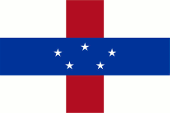 |
1986–2010, Nationalflagge – national flag, Seitenverhältnis – ratio = 2:3, Quelle/Source nach/by: Wikipedia (D)   |
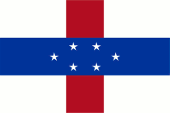 |
1959–1986, Nationalflagge – national flag, Seitenverhältnis – ratio = 2:3, Quelle/Source nach/by: Wikipedia (D) |
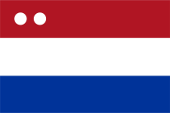 |
bis/to 1930, Flagge des Gouverneurs der Niederländischen Antillen – flag of the governor of the Netherlands Antilles, Seitenverhältnis – ratio = 2:3, Quelle/Source nach/by: Flags of the World |
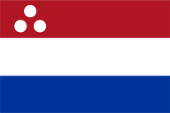 |
1930–1966, Flagge des Gouverneurs der Niederländischen Antillen – flag of the governor of the Netherlands Antilles, Seitenverhältnis – ratio = 2:3, Quelle/Source nach/by: Flags of the World |
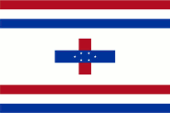 |
1966–1987, Flagge des Gouverneurs der Niederländischen Antillen – flag of the governor of the Netherlands Antilles, Seitenverhältnis – ratio = 2:3, Quelle/Source nach/by: Flags of the World |
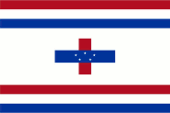 |
1987–2010, Flagge des Gouverneurs der Niederländischen Antillen – flag of the governor of the Netherlands Antilles, Seitenverhältnis – ratio = 2:3, Quelle/Source nach/by: Wikipedia (D) |
| Die Flagge der Niederländischen Antillen wurde 1959 erstmals gehisst. Sie zeigte – wie die Flagge der Niederlande selbst – zwei Streifen in Rot und Blau auf Weiß, jedoch über Kreuz angeordnet. Blau stand hier für die Karibische See. Die fünf weißen fünfzackigen Sterne standen für die fünf Inseln, welche zu den Niederländischen Antillen gehören. Im Zusammenhang mit der Trennung der Insel Aruba von den Niederländischen Antillen musste bereits am 01.01.1986 ein sechster Stern erntfernt werden. Die Farben der Flagge schienen folgendermaßen definiert zu sein, und zwar: Blau = HEX #002588, was Reflex Blue oder besser Pantone 622 entsprechen würde, Rot = HEX #DD1017, was Pantone 2035 oder besser Pantone 1788 entsprechen würde. Damit würden sich die Farbtöne von Rot und Blau von denen der niederländischen Flagge ein wenig unterschieden haben. Diese sind seit 1958 definiert, und zwar: Blau = HEX #1E4785, was Pantone 541 entsprechen würde, Rot = HEX #A91F32, was Pantone 187 entsprechen würde. | The flag
of the Netherlands Antilles was hoisted for the first time in 1959. It showed
– like the flag of the Netherlands itself – two stripes in red and blue on
white ground, but placed crosswise. Blue stood here for the Caribbean Sea.
The five white five-pointed stars stood for the five islands which belong to
the Netherlands Antilles. In occasion of the separation of Aruba Island from the Netherlands Antilles they had to remove one sixth star already on the 1st of January in 1986. The colours of the flag seemed to be defined as follows: Blue = HEX #002588, which would correspond to Reflex Blue or better Pantone 622, Red = HEX #DD1017, which would correspond to Pantone 2035 or better Pantone 1788. This would make the hues of red and blue slightly different from those of the Dutch flag. These have been defined since 1958, namely: Blue = HEX #1E4785, which would correspond to Pantone 541, Red = HEX #A91F32, which would correspond to Pantone 187. |
| Quelle/Source: 1) Wikipedia (EN), 2) Wikipedia (EN), Volker Preuß | |
Wappen – Coat of Arms: |
|
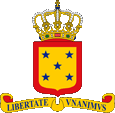 |
bis/to 2010, Wappen der Niederländischen Antillen – coat of arms of the Netherlands Antilles, Quelle/Source, nach/by: Flags of the World |
| Das Wappen der Niederländischen Antillen zeigte einen rot umrandeten goldenen Schild mit fünf blauen fünfzackigen Sternen, darüber die niederländische Krone. Das goldene Schriftband unter dem Schild zeigte das Motto "LIBERTATE UNANIMUS" → "EIMÜTIG IN DER FREIHEIT". Die Farben Gelb (Gold) und Rot gehen wahrscheinlich auf die früheren spanischen Herren der Inseln zurück. Die fünf Sterne stehen für die fünf Inseln, die zu den Niederländischen Antillen gehören. Zusammenhang mit der Trennung der Insel Aruba von den Niederländischen Antillen musste bereits am 01.01.1986 ein sechster Stern erntfernt werden. | The coat
of arms of the Netherlands Antilles showed a red bordered golden shield with
five blue five-pointed stars, above the Dutch crown. The golden banner below the shield showed the motto "LIBERTATE UNANIMUS" → "UNANIMOUS IN FREEDOM". The colours yellow (gold) and red have its roots probably in the former Spanish lords of the islands. The five stars stand for the five islands which belong to the Netherlands Antilles. In occasion of the separation of Aruba Island from the Netherlands Antilles they had to remove one sixth star already on the 1st of January in 1986. |
| Quelle/Source: Wikipedia (DE) | |
| Landkarte – Map: |
|
| Zahlen und Fakten – Numbers and Facts: | |
|
|
|
|
|
|
|
|
|
|
|
|
|
|
|
|
|
|
|
|
|
|
1499
· Entdeckung der Insel Curaçao 1527 · Spanien nimmt die Inseln in Besitz 1634 · Beginn der niederländischen Kolonisierung, jedoch häufige Wechel zwischen niederländischem und britischem Besitz 1816 · der niederländische Besitz der Inseln wird vertraglich bestätigt 1951 · die Niederländischen Antillen erhalten innere Autonomie 1981 · die Insel Aruba fordert erstmals mehr Autonomie innerhalb der Niederländischen Antillen 1986 · die Insel Aruba verlässt den Verbund der Niederländischen Antillen weitestgehend 10.10.2010 · die Niederländischen Antillen werden administrativ aufgelöst – Curaçao und Sint Maarten werden autonome Länder innerhalb der Niederlande (wie schon Aruba 1986), Bonaire, Sint Eustatius und Saba werden Besondere Gemeinden der Niederlande, die jedoch zu keiner Provinz gehören |
|
1499
· discovery of Curaçao Island 1527 · Spain appropriates the islands 1634 · begin of the Dutch colonization, but frequent changes between Dutch and British ownership 1816 · the Dutch ownership of the islands becomes confirmed contractually 1951 · the Netherlands Antilles get internal autonomy 1981 · Aruba Island demands for the first time for more autonomy within the Netherlands Antilles 1986 · Aruba Island leaves the association of the Netherlands Antilles most appreciably 10th of October 2010 · Netherlands Antilles become dissolved administratively – Curaçao and Sint Maarten become an autonomous country within the Netherlands (like Aruba in 1986), Bonaire, Sint Eustatius and Saba become special municipalities of the Netherlands, but don't belong to any province |
| Quelle/Source: Atlas zur Geschichte, Wikipedia (DE), Länder der Erde |
| Als die Spanier die vielen Inseln der Kleinen Antillen entdeckten, gaben sie ihnen den Namen "Islas Inútiles", was "Nutzlose Inseln" bedeutet. Aus den "Inútiles" wurden mit der Zeit die "Antilles". | As the Spaniards discovered the lots of small islands of the Lesser Antilles they named them "Islas Inútiles" what means "Useless Islands". In the course of times the "Inútiles" became the "Antilles". |
| Quelle/Source: Wikipedia (DE) | |